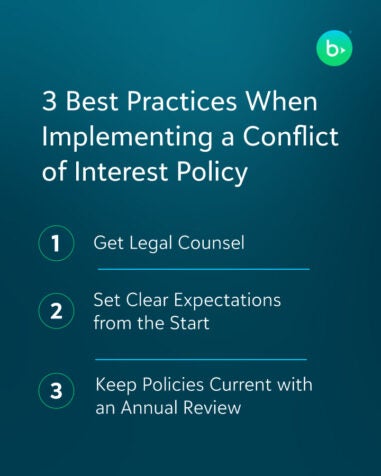Conflict of Interest Guidelines Every Grantmaker Should Follow

Humans are complicated creatures. While, as grantmakers, you see a lot of amazing work humans do every day, you also recognize that humans have many responsibilities that sometimes conflict. For example:
- The board member who owns an advertising agency and offers a discounted rate to the organization to design materials for their gala
- The Executive Director whose husband is a cybersecurity consultant and can identify any potential issues with the organization’s data collection
- The external reviewer who volunteers for the nonprofit that applied for the grant he’s helping with
These conflicts all start with good intentions, but without the right safeguards, they can undermine your organization’s transparency. This is why you need a conflict of interest policy.
When you’ve documented and implemented a strong conflict of interest policy, you protect your team, ensure ethical decision-making, and strengthen your reputation among grantees and stakeholders.
We talked with Adriana Cosgriff of Capacita, a consulting company that builds capacity for foundations and nonprofits, on why this essential tool deserves your attention—and how it can be tailored to fit your grantmaking organization’s unique needs.
Building Trust and Integrity Through a Well-Defined Conflict of Interest Policy
A conflict of interest (COI) policy is more than just a document—it’s a vital safeguard for your grantmaking organization, so decisions are made with integrity, transparency, and fairness. It helps you navigate complex relationships, maintain legal compliance, and solidify the trust of your stakeholders. Whether you’re working with board members, leadership, or external grant reviewers, a COI policy provides clear guidance on how to address potential conflicts, so everyone is operating in the best interest of your mission.
When your leadership, potential hires, and reviewers disclose and address conflicts upfront, it creates an environment of openness, which reassures your grantees, donors, and other stakeholders that your organization’s decisions are impartial and grounded in fairness.
“I think if you are exercising this power in civil society, in being responsible for decision making in a grantmaking organization, you need to be able to demonstrate how you are acting with integrity, and how you are exercising your charitable purpose conscientiously,” Adriana said. “And so, in practice, it’s being able to say we have a policy. This is what it looks like. This is what it protects, and this is how we deal with inevitable human conflicts.”
From a legal perspective, a COI policy is an essential compliance tool. Adhering to legal standards such as federal IRS requirements or state regulations is non-negotiable. A clear policy helps you define roles, outline procedures, and avoid any missteps that could jeopardize your organization’s standing or tax-exempt status. Proactively addressing potential conflicts helps your organization operate within the bounds of the law, reducing the risk of penalties or reputational damage.
Key Elements of an Effective Conflict of Interest Policy
A well-crafted COI policy helps establish clear expectations, provides a framework for managing potential issues, and protects your organization’s integrity. Here are the key components your policy should include to effectively address conflicts of interest:
Disclosure Expectations
Your policy should clearly outline the expectation that individuals disclose any actual, potential, or perceived conflicts as soon as they arise. This includes financial, relational, or other non-financial conflicts that might compromise impartial decision-making.
“I love in legal ethics this idea of avoiding even ‘the appearance of impropriety,’” Adriana said. “The idea is to avoid anything that has a whiff of being improper. And that’s such a great way to think about the less obvious things that could get you in trouble, or what should be disclosed in conflicts of interest.”
For example, imagine your organization needs to hire a consultant to clean up your CRM data. A board member offers the name of someone they worked with in the past and, in accordance with the COI policy, discloses that not only did the consultant do great work, but they are also friends. So, the organization can move forward with that information.
Conflict Management
Once a conflict is disclosed, your policy should specify a clear process for addressing it. Often the conflicted individual will recuse themselves from discussions or decisions related to the matter. Your policy might also include steps such as appointing a neutral party to explore alternatives or requiring additional vetting to verify decisions are based on merit rather than personal influence.
For instance, if a grant reviewer discloses a connection to an applicant, the organization might assign the review to another team member or seek external input to verify the grant review process remains unbiased.
The goal is to handle conflicts in a way that preserves the integrity of your organization’s decision-making while still allowing all parties to participate in appropriate roles.
Processes for Undisclosed Conflicts
Even with the best intentions, conflicts may go undisclosed—whether due to oversight or a lack of understanding about what constitutes a conflict. Your policy should outline steps for identifying and addressing these situations. This could involve discussing the issue with the individual involved, reviewing the circumstances with a governing board or committee, and implementing corrective actions as needed.
The policy should also emphasize that failure to disclose a conflict may result in consequences, such as removal from a position or reassignment of duties, to uphold accountability.
Industry- and Impact-Area-Specific Language
A COI policy is not a one-size-fits-all document. It must reflect the unique operations, challenges, and goals of your organization. Your policy should be customized to address the types of relationships and decisions specific to your work.
For example, a nonprofit focused on community health may encounter situations involving local hospitals or pharmaceutical companies, while a policy-oriented organization might face political or advocacy-related conflicts. These specifics dictate the type of language and processes that should be included in your policy.
Talk with your attorney—don’t rely on Google. This critical step ensures your policy is both practical and compliant with legal requirements.
Best Practices for Implementing a Conflict of Interest Policy
Implementing a COI policy effectively requires more than just drafting a document. It should be embedded into your organization’s culture and processes.
“Communication and transparency for me go hand-in-hand because so much of good leadership requires good communication,” Adriana said. “And in this case, it’s even more important because it is the right thing to do—and it’s the law.”

1. Get Legal Counsel
While templates can offer a useful starting point, they are not tailored to your organization’s legal obligations or operational realities. Relying solely on internet searches or generic documents risks missing crucial elements required for compliance. Instead, work closely with legal counsel to develop a policy that aligns with state and federal laws and accounts for the specific needs of your organization. As Adriana noted, “You don’t want to be noncompliant by accident just because you weren’t paying attention. That’s not a good excuse.”
Legal counsel can guide you through complex regulations such as IRS requirements for nonprofit organizations, state-specific rules, or industry standards. They can also help you refine processes for addressing undisclosed conflicts to provide accountability while protecting your organization’s reputation.
2. Set Clear Expectations from the Start
Every new board member, leader, or grant reviewer should receive a copy of your COI policy during recruitment or onboarding and be encouraged to discuss any potential conflicts at the outset. By setting clear expectations early, you foster an environment of transparency and accountability.
Walk individuals through the policy, so they understand what qualifies as a conflict and the steps to disclose and address it. This not only empowers them to comply but also helps eliminate confusion or hesitation down the road. Make the conversation interactive—invite questions and clarify how the policy applies to their specific role.
3. Keep Policies Current with an Annual Review
Laws and organizational processes can change, and your policy should evolve to reflect these shifts. Use the annual review as an opportunity to revisit and update the policy—alongside your legal counsel—so it aligns with your organization’s mission and any legal requirements.
During these reviews, ask stakeholders to complete an annual statement affirming they’ve read, understood, and agreed to comply with the policy. This ongoing affirmation provides a moment for individuals to identify any new conflicts that may have arisen since their last disclosure.
Annual reviews also serve as a chance to reinforce the importance of the policy across your team. Incorporate these discussions into board or staff meetings focused on governance to keep the topic visible and top-of-mind.
Integrity and Trust in Grantmaking Through Effective COI Policies
An effective COI policy is a cornerstone for ensuring transparency, fairness, and ethical decision-making in grantmaking organizations. By addressing potential conflicts upfront, organizations safeguard their reputations, protect stakeholders, and uphold the trust placed in them by grantees and the communities they serve.
Take proactive steps to implement and review your policy and empower your team to make informed decisions that are above reproach. Protect your organization, your stakeholders, and your charitable mission by prioritizing a COI policy that works for you. If you’re ready to refine or evaluate your approach, consult with your legal advisors and explore best practices to strengthen your governance framework today.
Internal controls, like your COI policy, are instrumental for creating consistent workflows that help you mitigate risk. Want to learn more about the importance of internal controls for grantmakers? Check out our guide, Internal Controls for Grantmakers: How to Drive Operational Efficiency for Better Outcomes.


